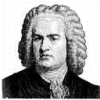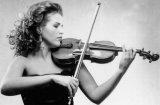
J.S.Bach
The world of Bach's concerti for various instruments is a complicated one. What survives is 2 concerti for solo violin (BWV 1041-1042), a concerto for two violins (BWV 1043), a triple concerto for flute, violin and harpsichord (BWV 1044), 6 other concerti for groups of solo instruments (The
Brandenburg Concerti, BWV 1046-1051), and 14 concerti for one or more harpsichords (BWV 1052-1065).
The difficulty begins with the fact that the harpsichord concerti were probably all originally written for other instruments, and transcribed by Bach for the harpsichord. Most of the originals are now lost, and only the harpsichord transcriptions survive.
To confuse the issue, there have been many attempts to reconstruct the original concerti by musicians after Bach's death. So we now have “Bach's flute concerti” and “Bach's oboe concerti” (modern versions of the harpsichord concerti BWV 1053, 1055, 1056 and 1059) and even versions for the guitar.
Well, the three violin concerti on this CD are Bach originals, the only violin concerti that have thankfully survived. Their harpsichord versions also exist, although the plucked sound of the harpsichord and the singing, sustained tone of the violin makes them very different pieces of music:
Violin Concerto | Harpsichord Concerto |
A minor, BWV 1041 | G minor, BWV 1058 |
E major, BWV 1042 | D major, BWV 1054 |
D minor ("Double"), BWV 1043 | C minor, BWV 1062 |
Most of these concerti date from Bach's so-called Cöthen period from 1718-1723, a happy, productive time for Bach. His new employer, Prince Leopold of Anhalt-Cöthen seemed to be fond of the latest fad, the Italian-style Concerto, as typified by Vivaldi. The older German version had four movements, but Bach quickly adopted the Italian three-movement fast-slow-fast structure, the form that propelled it into the Classical period.
In Mozart's time, and from then on, the concerto became a showcase for the virtuoso soloist, the orchestra often in just a supporting role. Bach's concerti are very different. His is more a intricate dialog between orchestra and soloist, the solo instrument is very much a
primus inter pares, first among equals, often not taking the limelight but adding to the overall texture of the music.
Concerto for Violin and Orchestra No.1 in A minor, BWV 1041
A spontaneous, infectious first movement, hurtling inevitably forwards, contrasting sharply with the pastoral slow movement, the violin truly singing. And ending with a rolling, jolly final gigue, famous for Bach's instruction to the soloist for
bariolage, a bowing technique where a single note is played repeatedly alternating on stopped and open strings, producing a unique effect.
Concerto for Violin and Orchestra No.2 in E major, BWV 1042
This concerto opens with a rising triad, the simplest of melodies, yet results in a tune of great joy and spirit. The
Adagio central movement is hauntingly beautiful, from a very simple form of repeating bassline, and a floating violin melody. It is a Bach trademark to create such emotion from such rigid form.
Concerto for 2 Violin and Orchestra in D minor, BWV 1043
The best-known of Bach's violin concerti, and the star of the CD is the “Double” Violin Concerto in D minor. All the great violinists have recorded it. It is one of Bach's (many) masterpieces.
It opens with a Bachian fugue, each violin answering the other, rapidly alternating the melodic line, carrying different tunes yet so closely intertwined as to be inseperable, their combined voices miraculously greater than the sum of their parts.
The central
Largo is one of Bach's most sublime creations, almost an operatic aria for two vioces. Bach can be almost mathematical at times, but this
Largo is Bach at his most accessible, most tender, most human.
The
Allegro finale brings out Bach the architect, Bach the craftsman. The writing here is so complex it is difficult to follow the individual violins. Simply let it wash over you and be amazed.

Anne-Sophie Mutter
Anne-Sophie Mutter was just 20 years old when she made this recording, having been recently discovered by Herbert von Karajan. She is now best known for her virtuoso playing of the most difficult violin repertoire (see our review of her
Carmen-Fantasie CD), and also for her championing and commissioning of new music.
On this CD she displays more restrained, more music and less pyrotechnics. Immaculate is the best word to describe the performances.
She is joined by Salvatore Accardo for the Concerto for Two Violins, and the combination of the experienced older violinist with the more fiery Mutter brings out some interesting nuances. The concerti are played quite slowly (compared to some other versions) which brings out the expansive, almost regal nature of these masterpieces by Bach. This is an extremely fine recording of essential Bach, a no-risk CD.
Please support Good-Music-Guide.com
by purchasing this CD using this link.

Track Listing
Johann Sebastian Bach
Violin Concertos
Salvatore Accardo
Anne Sophie Mutter
English Chamber Orchestra
Violin Concerto No. 2 in E major, BWV 1042
- I: Allegro
- II: Adagio
- III: Allegro assai
Concerto for 2 violins & strings in D minor ("Double"), BWV 1043
- I: Vivace
- II: Largo ma non tanto
- III: Allegro
Violin Concerto No. 1 in A minor, BWV 1041
- I
- II: Andante
- III: Allegro assai